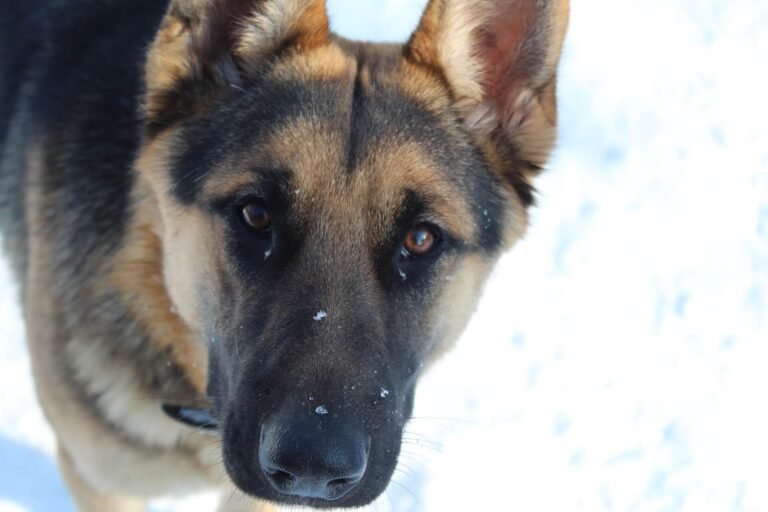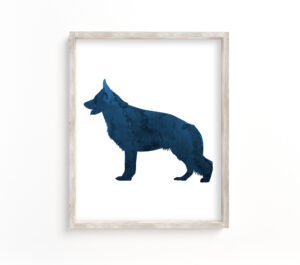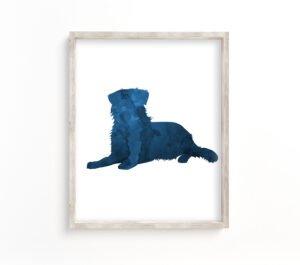Australian Shepherd mixed with German Shepherd
The Australian and German Shepherd mix combines two highly intelligent working breeds.
A hybrid between two dog breeds results in offspring with similar treats as their parent dogs. So let’s have a closer look at both dog breeds to figure out which characteristics a dog with Australian Shepherd and german shepherd parents will have.

The Australian Shepherd – aka Aussie
Australian Shepherd – a herding dog originally bred in the mid-1800s by Australian ranchers for sheep work. It is also the mascot of the University of California, Davis. Aussies are usually agile, alert, and energetic, with various coat colors. Coat colors may be red merle, tri-colored, black and tan, blue merle, or solid color. The breed has a happy disposition that makes them especially suitable as companion dogs. In addition, because they are so affectionate and friendly to both humans and other animals, this dog may do well with children old enough to treat animals responsibly.
However, they should not be left unattended around small pets that might provoke their protective instincts. The Australian Shepherd needs early socialization to learn how to interact appropriately with other animals. Aussies can be aggressive toward other animals if not properly socialized, as they have strong herding instincts.
The breed is known for having intelligence, obedience, agility, and protective instincts; in fact, these dogs are so intelligent that those bred for herding work may not even need training at all!
Aussie health conditions can include: hip dysplasia; eye problems such as cataracts or progressive retinal atrophy (PRA); deafness; immune disorders; skin allergies; epilepsy; hypothyroidism; diabetes mellitus; and ear infections. Allergies may be particularly prevalent in dogs with a merle coat (estimated at up to 80% incidence).
Height: 18 to 26 inches;
Weight: 30 to 50 pounds;
Lifespan: 13 – 15 years

The German Shepherd – aka … german Shepherd
A German Shepherd dog is a breed of large-sized working dog, which usually comes in black and brown colors. They are very skilled and make great guardians, but they can have an aggressive temperament if not properly trained. German Shepherds are one of the world’s most popular dogs. They are so versatile that they can be found in many different roles, from herding sheep to guarding your family at home. They are strong and very intelligent. As a result, they are easily trained and do well in things like agility and tracking.
German Shepherds are also often crossed with other breeds to vary the coat color and temperament, including the Australian Shepherd mix. They need plenty of exercises—ideally two hours per day at the minimum, more if you’re trying to train for competition in dog sports such as obedience or agility, even more, if there’s still some puppy in them. He should have access to an enclosed yard, if possible. Walks on the leash are not enough for this active breed, though a German shepherd may be able to do fine with less than two hours of exercise per day if he has other ways to burn off energy during the rest of the day example, training in dog sports.
If you live in an apartment or condo, though, and have no yard, consider adopting a different breed.
The most common reasons people give up German shepherds are housetraining problems and aggression toward other dogs or people. They are workaholic dogs who can chew through drywall during those first few months of their lives when they desperately want to find out what is on the other side. The only way to housebreak a German shepherd is to be very consistent and patient while using positive training methods.
They can accidentally knock down a toddler or preschooler without meaning to, so supervision is necessary when little kids are around these dogs. Many GSDs aren’t fond of cats either and may chase them or try to dominate them, which often results in injury to both parties.
German shepherds can be very territorial and protective dogs for their families. They will become overly attached to their owner and have powerful feelings about what goes on within his pack (his family). Therefore, he needs early socialization with both people and other animals.
Like the Australian Shepherd, the German Shepherd can be independent and may decide he knows better than you when it comes to certain things. However, both breeds are highly intelligent, so training them takes patience, persistence, and consistency.
German Shepherds have a wide variety of health problems. Hip and joint problems are very common, and there are many different remedies to help your dog feel better. Unfortunately, Whelping may also lead to complications like mastitis in nursing mothers.
Height: 18 to 26 inches;
Weight: 50 to 70 pounds;
Lifespan: 9 – 13 years
Australian Shepherd mixed with German Shepherd
An Australian German Shepherd mix will have typical characteristics like:
– Being Active
– Loyal
– Intelligent
– Requires lots of mental stimulation
The German Shepherd/Australian Shepherd mix can vary in color; they can be black, gray, white, and have the same range of hair types as their parents (long, short or medium). The coat color will depend on which parent the puppy looks closer to. This mixed breed has inherited its intelligence from both parents, but it may not always inherit its trainability. As a result, they generally get along well with strangers if socialized when young, but they could still be wary of strangers until adequately introduced at an early age.
On the other hand, Australian Shepherds are very much bred to work side by side with farmers as working dogs for various sheep-related jobs such as herding and protecting their flock from predators. Their intelligence also makes them good at tricks, and they adapt well into living situations where they need to be more sedentary. They are smaller than German Shepherds but share many similar physical attributes, including ears that stand upright on top of their heads (not floppy) and tails that curl upwards towards their backsides.
They have a thick coat that’s easy to maintain but frequently sheds (either seasonally or year-round, depending on the dog). The color variety in this breed is wide: black, red/dingo combination, blue merle, and tri-color/pied. They can make for a great family pet – they’re protective of their owners and will do pretty well with kids who treat them right. So long as you don’t leave them alone outside all day and expect them to chill out somewhere inside or tethered up where it’s hot all summer long (hot weather wilts these dogs), they’ll be fine. And like many herding breeds, they can be very vocal as far as training is concerned (barkers).
However, these dogs do need some special care. If you don’t want to groom them with a brush and scissors every few months, then you should pay for someone else to do so at the local grooming parlor. They have an average lifespan of around 10-14 years but can live as long as 17 if their health is good. As far as food goes, buy high-quality dog food. You might be tempted to feed them scraps off of your table. Still, too many dog owners do this without realizing that it can cause malnutrition in their dogs if done too often (they’ll look healthy but still have nutritional deficiencies).
Add Some Art To Your Home!
Add some art to your home with an art print of your favorite dog breed! We have German and australian shepherd prints in our store – perfect for decorating your home fast, easy, and affordable.
-
 $20.00 – $29.00 inc. VatSelect options This product has multiple variants. The options may be chosen on the product page
$20.00 – $29.00 inc. VatSelect options This product has multiple variants. The options may be chosen on the product page -
 $20.00 – $29.00 inc. VatSelect options This product has multiple variants. The options may be chosen on the product page
$20.00 – $29.00 inc. VatSelect options This product has multiple variants. The options may be chosen on the product page -
 $20.00 – $29.00 inc. VatSelect options This product has multiple variants. The options may be chosen on the product page
$20.00 – $29.00 inc. VatSelect options This product has multiple variants. The options may be chosen on the product page -
 $20.00 – $29.00 inc. VatSelect options This product has multiple variants. The options may be chosen on the product page
$20.00 – $29.00 inc. VatSelect options This product has multiple variants. The options may be chosen on the product page -
 $20.00 – $29.00 inc. VatSelect options This product has multiple variants. The options may be chosen on the product page
$20.00 – $29.00 inc. VatSelect options This product has multiple variants. The options may be chosen on the product page -
 $20.00 – $29.00 inc. VatSelect options This product has multiple variants. The options may be chosen on the product page
$20.00 – $29.00 inc. VatSelect options This product has multiple variants. The options may be chosen on the product page -
 $20.00 – $29.00 inc. VatSelect options This product has multiple variants. The options may be chosen on the product page
$20.00 – $29.00 inc. VatSelect options This product has multiple variants. The options may be chosen on the product page -
 $20.00 – $29.00 inc. VatSelect options This product has multiple variants. The options may be chosen on the product page
$20.00 – $29.00 inc. VatSelect options This product has multiple variants. The options may be chosen on the product page